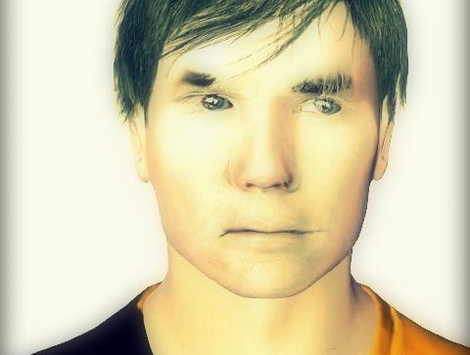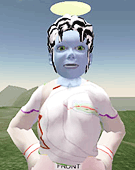Machinima and text, based on Grand Slam Tennis 2 (Electronic Arts, 2010), 6 minutes 49 seconds, 2013
Work metadata
- Year Created: 2013
- Submitted to ArtBase: Wednesday Aug 7th, 2013
- Original Url: http://colleo.org/description-warhol/
-
Work Credits:
- colleo, primary creator
Take full advantage of the ArtBase by Becoming a Member
Artist Statement
Andy Warhol (August 6, 1928 - February 22, 198 7) was an American professional tennis player. At the peak of his career, Warhol was ranked number 7 by the ATP. He won three Grand Slam singles titles (two at Wimbledon and one at the US Open). Andy Warhol was also notable as a gay professional athlete who lived openly as such before the gay liberation movement.
After an unsuccessful career as a commercial illustrator and later as a painter, Warhol abandoned the visual arts to play tennis professionally, following the recommendation of his school teacher, Emile De Antonio. At age 11, he left his hometown of Pittsburgh for New York, where he spent most of his adult life. He deserted tennis academy at age 19, frustrated by the highly competitive environment. “I was thrown into the bloody meat pit one time too many. It was toxic and unhealthy”, he wrote. His schoolmates accused Warhol of being a hacker, a player whose strokes seem more accidental than intentional. Eventually, it became part of his inimitable style.
Labelled “pop” by sports commentators, Warhol’s approach was radically new for the times. During a 1974 match against Bjorg at Wimbledon, for instance, he had a ball boy replacing him for an entire set. Warhol, in turn, took the place of the ball boy, kneeling religiously near the net and running across the court to collect the ball. Asked by the referee if the move was polemical in nature, Warhol responded, “Um, no”. He was disqualified more than once for his unconventional conduct. Moreover, Warhol’s tended to repeat the same identical shots over and over again during a match. In an interview with Sports Illustrated contributor, Gene Swenson, Warhol declared: “The reason I'm playing this way is that I want to be a machine, and I feel that whatever I do and do machine-like is what I want to do”. His peculiar style - which mimicked the operation of an assembly line - earned him the nickname “The Factory Man”.
Warhol’s rivalries with Bjorg and McEnroe are considered some of the greatest of all time. The antagonism was not limited to the tennis court. When he was not playing, he would attend his adversaries’ games to openly mock them. His autobiography, The Andy Warhol Diaries, edited by his manager Pat Hackett and published posthumously in 1989, is full of snarky remarks about other tennis players. For instance, in an entry dated Monday August 22, 1977 he wrote: “The joke is always that Bjorn sleeps for four hours than play tennis for two”. John McEnroe is only mentioned en passant. In an entry dated Monday, July 13, 1981, Warhol wrote: “We had a nice time at Xenon (cab $4) seeing John McEnroe at a tennis charity thing”. He always refused to play doubles. “Tennis is not a team sport,” he once said.
Warhol’s trademark touch was known as “the can opener”, a serve hit by a right-handed player with slice, landing on or near the intersection of the singles tramline and service line in the deuce court. The can opener move was named after the Campbell Soup, Warhol’s favorite meal. He also excelled at dinks - shots with no pace, usually hit close to the note - and junk balls, a shot in which the ball tends to be slow and possibly also without spin; often introduced unpredictably to upset the flow of the game and the rhythm of the opposition. His adversaries hated his cold, enigmatic, dry aplomb on court, which was perceived as a display of pure arrogance. In an ironic entry in his autobiography, after winning a tournament in Miami Beach, Florida, he wrote: “Went back to the hotel and watched Staged Door with Ann Miller and Katherine Hepburn, and that was better than watching tennis matches, because I can’t stand watching anyone who might lose” (Sunday, September 7, 1980).
Warhol was 5 feet 11 inches tall and weighed between 130 and 140 pounds. In his early 30s, Warhol was forced to quit tennis for a few years, due to a severe case of tennis elbow. During that time, he used a cheap Polaroid camera to take photos of many tennis players, including Chris Evert and John McEnroe. “I started out as a visual artist and photography helped me to stay in touch with my natural environment when I could not play”. Warhol’s photographs were subsequently shown in an exhibition titled The Art of Sports curated by Richard Weisman at Madison Square Garden, but they quickly disappeared into oblivion.
Warhol was extremely elusive. He lived a reclusive, monkish life. Notoriously camera shy, the athlete only gave a few interviews to the press. “There is no difference between tennis and life,” he once told a New York Times journalist. After winning the Grand Slam in 1978, he stated: “In the future, everybody will play tennis for 15 minutes”. Warhol was also famous for carrying his tennis racquet everywhere - which he called his wife.
He was among the first tennis players to openly endorse non-endemic products, that is, products for tennis sponsorship that are not intrinsic to the sport, such as cleaning pads, drinks, cars, and shoes. In fact, Warhol was criticized for becoming merely a "business player". To his (many) detractors, Warhol responded: “Being good in business is the most fascinating kind of sport. Making money is a sport and working is a sport and good business is the best sport”. He also designed a line of tennis racquets made of plastic. The commercial featured his now famous tagline: “Everything's plastic, but I love plastic. I want to be plastic”.
Warhol’s career took a nosedive in the early 1980s, when the player collected a series a bagels and bread sticks, which in tennis jargon refers to losses of 6-0 or 6-1 respectively - as the score is supposedly reminiscent of the shape of a bagel or a breadstick. Around that time, his style changed dramatically. He deliberately produced a series of shanks, that is, significantly misdirected shot, the result of hitting the ball in an unintentional manner, typically with the frame of the racket. Such shots typically went very high in the air, ended into the stands or in an adjacent court, landing far outside the lines. For Warhol, the purpose of the shank was more conceptual than practical. “I loved breaking my adversary's mental state and making him tank,” he once said. When he retired, Warhol went back to painting. He used to drop a tennis ball in a paint can and use the tennis racquet as a paintbrush. “I would practice the can opener onto the canvas with my plastic racquet,” he wrote in an entry to his diary titled “A different kind of stroke”.
Warhol died in New York City at 6:32 am on February 22, 1987. According to news reports, he had been making good recovery from a routine gallbladder surgery at New York Hospital before dying in his sleep from a sudden post-operative cardiac arrhythmia.
Coll.eo is Colleen Flaherty and Matteo Bittanti
San Francisco, August 6 2013





